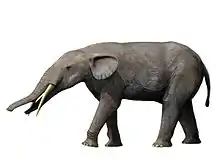Cuvieronius
Cuvieronius is an extinct New World genus of gomphotheres and is named after the French naturalist Georges Cuvier. Alive, specimens typically stood about 2.3 m (7.5 ft) tall at the shoulder, weighed about 3.5 t (3.4 long tons; 3.9 short tons)[2] and would have superficially resembled a modern elephant with spiral-shaped tusks.
| Cuvieronius | |
|---|---|
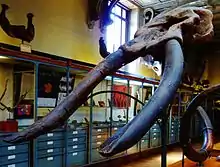 | |
| Skull of C. hyodon Muséum national d'Histoire naturelle, Paris | |
| Scientific classification | |
| Kingdom: | Animalia |
| Phylum: | Chordata |
| Class: | Mammalia |
| Order: | Proboscidea |
| Family: | †Gomphotheriidae |
| Genus: | †Cuvieronius Osborn, 1923 |
| Type species | |
| †Mastotherium hyodon Fischer, 1814 (conserved name) | |
| Species[1] | |
| |
| Synonyms | |
|
Cuvieronius
C. hyodon
| |
Taxonomy

The species now known as Cuvieronius hyodon was among the first fossil animals from the New World to be studied. The first remains of this species were recovered from Ecuador by Alexander von Humboldt, at a location the local population referred to as the "Field of Giants".[3] Humboldt recognized that, rather than being bones of giant humans as had been thought by the local population and previous Spanish colonists, they were similar to the giant elephants (Mastodon) being described from Ohio. Humboldt sent teeth that he had collected from Mexico, Ecuador, and Chile to French anatomist Georges Cuvier, who classified the teeth into two species, which he referred to as the "mastodonte des cordilières" and the "mastodonte humboldtien", in an 1806 paper.[4] It was not until 1824 that Cuvier formally named the species. He referred both to the genus Mastodon, calling them M. andium and M. humboldtii.[4]
Unknown to Cuvier, Fischer had, in 1814, already named the two species based on Cuvier's original description, in the new genus Mastotherium as M. hyodon and M. humboldtii. The idea of two distinct species continued to be accepted into the 20th century, usually using Cuvier's names, though Fischer's names were older.[4] In 1923, Henry Fairfield Osborn recognized that these species were distinct from Mastodon, and assigned each to its own new genus, as Cuvieronius humboldtii and Cordillerion andium. However, by the 1930s, general agreement had shifted to regard both forms as representing a single, geographically widespread species, with Cuvieronius humboldtii considered to be the correct name.[4] During the 1950s, the nomenclature of this species became increasingly tangled, as various scientists regarded the type species of the genus Cuvieronius to be Fischer's first published name Mastotherium hyodon, rather than the originally designated Mastodon humboldtii. This situation went unaddressed until 2009, when Spencer Lucas petitioned the International Commission on Zoological Nomenclature to officially change the type species of Cuvieronius to M. hyodon as had been followed for over 50 years by that time, rather than abandoning the well-known Cuvieronius as a synonym.[4] In 2011, Opinion 2276 of the ICZN ruled to conserve the names.
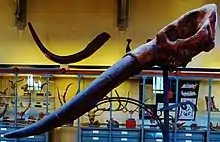
Evolution
Gomphothere phylogeny (after Mothé et al. 2016[5])
| |||||||||||||||||||||||||||||||||||||||||||||
Cuvieronius initially evolved in North America during the Late Pliocene. It is considered closely related to, if not derived from, Rhynchotherium, a North American gomphothere genus known from the Late Miocene and Pliocene.[6] Cuvieronius was expirated from most of North America during Irvingtonian after the arrival of mammoths in North America around 1.3 Ma, presumably due to competitive exclusion by mammoths and mastodons,[7] but persisted in southern North America until the very end of the Pleistocene. During the Great American Interchange , Cuvieronius and a relative, Notiomastodon, dispersed into South America.[8] Cuvieronius apparently reached South America considerably later than Notiomastodon, with the oldest possible date being 0.76 ±0.03 Mya and the oldest confirmed date being 304 ±54 ka, and had a much more restricted range, confined mostly to the Andes.[9]
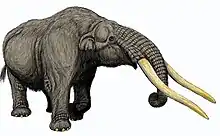
Cuvieronius remains have been identified as far south as Chile, with remains initially suggested to represent Cuvieronius at the Quereo I site (Quereo Quebrada) dating to the Late Pleistocene 11,600—11,400 BP.[10] However, more recent studies suggest that they were extirpated from South America by the end of the Late Pleistocene, before the arrival of people.[9]
Distribution and habitat
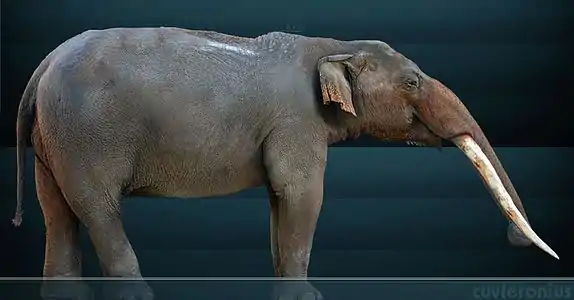
The oldest fossil remains to date are of Cuvieronius species found in Lincoln County, Nevada, which date to an accurate 4.6 million years ago (Mya). It was also found as far east as South Carolina and North Carolina in Pleistocene rocks dating to 1.81 million to 126,000 years ago. In Florida, remains show both Cuvieronius living from 2 to 0.5 Mya.[6] The most recent findings of Cuvieronius in North America are in Sonora, Mexico, that date to 13,390 years BP at a Clovis culture kill site.[11] As well as remains found near the town of Hockley in Texas near Austin, which date to around 24,000 years BP.[12]
According to a group of Brazilian mammalogists, many sites in South America referred to Cuvieronius actually refer to Notiomastodon, with many previous studies simply labeling fossils one or the other depending on location, with only localities definitely identified as Cuvieronius, the range now extends in the high Andes from Ecuador in the north, to Bolivia in the south, with the localities in the southern Andes in Chile and Argentina now thought to belong to Notiomastodon. The same group maintains that all the South American specimens represent the single species C. hyodon, and that no confirmed fossils of Cuvieronius are more recent than 44,000 years ago in South America, so the species would not have been in South America at the time of human arrival.[9] By the end of the Pleistocene, the northern limit of the range of Cuvieronius was in Mexico and Central Texas.[13]
Fossils of Cuvieronius have been found in the Ulloma and Tarija Formations of Bolivia, the Sabana Formation of Colombia,[14] Costa Rica, Ecuador, El Salvador, Guatemala, Mexico, Nicaragua, Panama, United States (Florida, New Mexico, North Carolina, Oklahoma, South Carolina, Texas), and Venezuela.[1]
An account has Cuvieronius remains being found in Ecuador with human artifacts dated around 200 to 400 AD.[15]
References
- Cuvieronius at Fossilworks.org
- Larramendi, A. (2016). "Shoulder height, body mass and shape of proboscideans" (PDF). Acta Palaeontologica Polonica. 61. doi:10.4202/app.00136.2014. S2CID 2092950.
- Mayor, A. (2005). Fossil legends of the first Americans. Princeton University Press.
- Lucas, S.G. (2009). Case 3479 Cuvieronius Osborn, 1923 (Mammalia, Proboscidea): Proposed conservation. Bull. Zool. Nomen, 66, 1-6.
- Mothé, Dimila; Ferretti, Marco P.; Avilla, Leonardo S. (12 January 2016). "The Dance of Tusks: Rediscovery of Lower Incisors in the Pan-American Proboscidean Cuvieronius hyodon Revises Incisor Evolution in Elephantimorpha". PLOS ONE. 11 (1): e0147009. Bibcode:2016PLoSO..1147009M. doi:10.1371/journal.pone.0147009. PMC 4710528. PMID 26756209.
- Lucas, S.P., 2008a. Cuvieronius (Mammalia, Proboscidea) from the Neogene of Florida. In: Lucas, S.P., Morgan, G.S., Spielmann, J.A., Prothero, D.R. (Eds.), Neogene Mammals, vol. 44. N. M. Mus. Nat. Hist. Sci. Bull., pp. 31e38
- Smith, Gregory James; DeSantis, Larisa R. G. (February 2020). "Extinction of North American Cuvieronius (Mammalia: Proboscidea: Gomphotheriidae) driven by dietary resource competition with sympatric mammoths and mastodons". Paleobiology. 46 (1): 41–57. doi:10.1017/pab.2020.7. ISSN 0094-8373.
- Prado, J. L.; Alberdi, M. T.; Azanza, B.; Sánchez, B.; Frassinetti, D. (2005). "The Pleistocene Gomphotheriidae (Proboscidea) from South America". Quaternary International. 126–128: 21–30. Bibcode:2005QuInt.126...21P. doi:10.1016/j.quaint.2004.04.012.
- Mothé, D.; dos Santos Avilla, L.; Asevedo, L.; Borges-Silva, L.; Rosas, M.; Labarca-Encina, R.; Souberlich, R.; Soibelzon, E.; Roman-Carrion, J.L.; Ríos, S.D.; Rincon, A.D.; de Oliveira, G.C.; Lopes, R.P. (2017). "Sixty years after 'The mastodonts of Brazil': The state of the art of South American proboscideans (Proboscidea, Gomphotheriidae)". Quaternary International. 443: 52–64. Bibcode:2017QuInt.443...52M. doi:10.1016/j.quaint.2016.08.028.
- Paleobiology database, Collection 71265, Quereo Quebrada, Chile. Authority: John Alroy February 5, 1999.
- Sanchez, Guadalupe; Holliday, Vance T.; Gaines, Edmund P.; Arroyo-Cabrales, Joaquín; Martínez-Tagüeña, Natalia; Kowler, Andrew; Lange, Todd; Hodgins, Gregory W. L.; Mentzer, Susan M. (2014-07-29). "Human (Clovis)–gomphothere (Cuvieronius sp.) association ∼13,390 calibrated yBP in Sonora, Mexico". Proceedings of the National Academy of Sciences. 111 (30): 10972–10977. Bibcode:2014PNAS..11110972S. doi:10.1073/pnas.1404546111. ISSN 0027-8424. PMC 4121807. PMID 25024193.
- Lundelius, Ernest L.; Thies, Kenneth J.; Graham, Russell W.; Bell, Christopher J.; Smith, Gregory James; DeSantis, Larisa R.G. (October 2019). "Proboscidea from the Big Cypress Creek fauna, Deweyville Formation, Harris County, Texas". Quaternary International. 530–531: 59–68. Bibcode:2019QuInt.530...59L. doi:10.1016/j.quaint.2019.11.018.
- Graham, R. W. (2001). "Late Quaternary Biogeography and Extinction of Proboscideans in North America" (PDF). In Cavarretta, G.; Gioia, P.; Mussi, M.; Palombo, M. R. (eds.). The World of Elephants (La Terra degli Elefanti) - Proceedings of the 1st International Congress [Atti del 1o Congresso Internazionale], Rome October 16–20, 2001. Rome: Consiglio Nazionale delle Ricerche. pp. 707–709. ISBN 88-8080-025-6. Retrieved 2010-02-27.
- Correal Urrego, 1990, p.77
- D. M. S. Watson, History of Elephants
Bibliography
- Cooke, Richard. 1998. Human settlement of Central America and northernmost South America (14,000-8000 BP). Quaternary International 49/50. 177–190.
- Correal Urrego, Gonzalo. 1990. Evidencias culturales durante el Pleistocene y Holoceno de Colombia - Cultural evidences during the Pleistocene and Holocene of Colombia. Revista de Arqueología Americana 1. 69–89. Accessed 2016-07-08.
External links
- American Museum of Natural History Includes images


